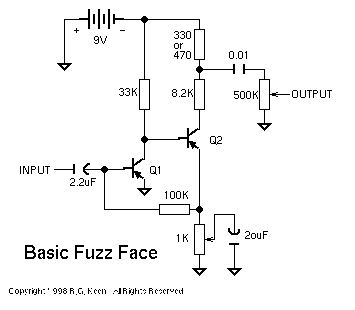
Copyright 1998 R.G. Keen All Rights Reserved.
The term "Fuzz Face" is a registered trademark of Dunlop.
[Picking Transistors] [A Peek
at the Circuit] [Mods]
Introduction
The Fuzz Face remains an enigma today, perhaps three decades after it first hit the market. This simple, two transistor circuit remains for many the very definition of the guitar effects stomp pedal. What makes such a simple circuit the stuff of legend?
For one thing, it's got a reputation. There can't be many guitarists that
don't know that a lot of Jimi Hendrix' songs were cut with a Fuzz Face. But
Jimi had, above all else, a good ear. If it didn't sound good, he wouldn't
have used it, and furthermore, it didn't have a rep when he picked it up. A
reputation is good reason to look at it today, but not in the beginning.
A Peek at the Circuit

Let's look at the circuit. This is simple almost beyond belief for distortion devices. Two transistors, four resistors, three capacitors, and two controls make all that tone. The first transistor is set up with the simplest of arrangements - input through a DC blocking capacitor directly to the base, emitter grounded, and a single collector resistor; the driven load is a second transistor base, directly coupled. Ordinarily this would be the maximum possible gain arrangement, except that there is that resistor coming from the second transistor's emitter - what's that do?
For DC purposes, the second transistor acts as an emitter follower. The voltage at it's emitter must follow the first transistor's collector, although it is lower by the amount of the base emitter drop of the second transistor. To the first transistor, that means that the 100K resistor from the emitter of the second transistor to the first transistor's base is effectively a feedback resistor, passing a current proportional to the first transistor's collector voltage to the first transistor's base. This arrangement is called the "voltage feedback biasing" circuit, and some of the Fuzz Face's unique properties stem from this.
The Voltage Feedback (VF) circuit has the properties that it offers the potential for the highest possible gain from any given transistor - good for a distortion device. It also has a very low input impedance, which means that it heavily loads anything trying to drive it. This will be an important point later. Finally, it can't really hard saturate like many other transistor hookups. When driven with a large signal on the base, the collector voltage moves toward the emitter. This lowers the bias voltage through the 100K biasing resistor, and steals some of the input signal. Saturation is mushy - again, very good for a musical sounding device.
Was this intentional on the part of the designer? Probably not. It's likely it was a happy accident, as the VF circuit was common in the early days of circuit design to wring more gain from poor transistors.
The voltage swing in the other direction, when the input is trying to turn the first transistor off, is not as constrained as the swing towards saturation. Fuzz Faces naturally tend to bias with only about half a volt on the collector of the first transistor, so there is a lot of room upwards. The input stage will first hit mushy saturation on one polarity of signal and then if driven hard enough, hit cutoff on the other polarity. The Fuzz Face has asymetrical clipping designed into it!
The second transistor serves a couple of purposes. The base is directly coupled to the collector of the first transistor; the bias current then is largely set by the value of the emitter resistor - in this case a 1K pot. The pot forces the static current through the device to be equal to the first collector voltage minus the base emitter voltage of the second transistor, divided by the 1K resistance. That same current, essentially, flows through the collector resistance of the device, and the voltage across the two collector resistors is equal to the static current times the sum of the resistances. Because the first transistor biases up so close to ground, there is still plenty of room for the second transistor to have some collector-emitter voltage left over for a linear swing.
The gain of the second stage is approximately determined by the ratio of the AC load in the collector to the AC load on the emitter. The AC collector load is just the sum of the collector resistors, and the emitter load to AC is the portion of the 1K pot not "shorted" to ground through the 20uF capacitor. So the gain can vary from a low of about 8 to as high as the transistor's basic internal gain when the pot is maxxed out. There is a secondary effect in that the AC gain of the FIRST stage is also set by the AC feedback from that pot through the 100K resistor, so when the control is turned full down, the feedback reduces the first stage's gain most. As the control is turned up more, less AC is fed back to the input, so the effective gain goes up.
As the second stage is driven harder, it can hard clip in cutoff on the same polarity that the first stage clipped softly on, so the clipping begins softly for smaller signals (and gains) and then transistions to hard clipping with harder playing - the thing gets touch sensitivity!
The split collector load resistor of the second transistor acts like a volume pot permanently set to a low value. This is because the power supply is effectively at AC ground because of the low AC impedance of the battery. Incidentally, this is why the FF sounds different with different batteries and with the same battery as it gets run down - the impedance of the battery can change the effective value of the smaller resistor by an significant amount.
The amount of signal tapped off at the junction of the two resistors is deliberately small, not much larger than the input signal to keep the (relatively!) huge amount of signal available from overdriving the input of the amp following it. The output volume control is an entirely ordinary volume pot. The output capacitor blocks the DC level from saturating any device following the Fuzz Face, as well as determining the lowest frequency that gets out. Making this cap bigger will let more low frequencies out.
The value of the output level control has been the subject of some
debate. Eric Johnson supposedly favors 100K over the stock 500K. This
could have some effect, as the 100K acts as a load on the collector resistor.
More importantly, it cuts more lows out by it's interaction with the output
coupling cap, and is less subject to stray capacitive loading cutting highs
than the 500K; a 100K should sound somewhat brighter.
What sounds good in there?
We've just hand waved the transistors as being there; there is a whole mythology that has grown up around those transistors. The earliest FF's were made with AC128's, a common Euro type at the time the FF was designed. It seems likely that the AC 128 was picked for it's cost and availability (in retrospect) rather than any super sound qualities.
It's hard to remember for people who were not into electronics 30 years ago, but transistors were not all that good or reliable. The tech community went to silicon for transistors because germanium is prone to leaking (can't turn the thing off!) and heat damage (solder too long and it dies). Silicon is much better about both of these things, and modern processes turn out closely clustered gains and very high frequency responses routinely.
The fact is that the AC128 is not a super high quality transistor, and wasn't at the time. It is a moderate gain (90 typical) device with only modest frequency response. It was HIGHLY variable in gain. I have measured several hundred AC128's for gain, and they vary from a gain of 16 to probably 180. I say probably because the measured gains actually turn in numbers up to 500 or so, which are clearly leaky devices, not high gain devices. The semiconductor industry was new back then, and had not developed the technologies that let us make cheap, reliable, identical-as-peas-in-a-pod devices like we have become accustomed to.
The variation in gain is important because it is crucial to the tone of the FF. Reliable reports from people who actually bought and sold volumes of FF's in the "golden years" say that out of a case of fifty units, they all distorted all right, but only a few would sound really good, right out of the box. It was common for guitarists to make deals to presort a batch to get a good one. This practice continues today, with Eric Johnson's tech supporters tracking down and interviewing FF's to find the few "magic" ones. Fuzz Faces per se do not necessarily sound good without tweaking and transistor selection.
We can understand this today. I've done a lot of circuit simulation on the FF, twiddling the values of the transistor gains, and looking at the clipping waveforms and resulting harmonic spectra. There is a definite sweet spot for musical sounding clipping at transistor gains of about 80-110. If you allow combinations of one high and one low gain device, the range widens out to 70 or so on the low end and perhaps 130 on the high end. Keeping in mind that preferences for distortion tone are definitely a matter of personal taste, the range of gains for unselected AC128's in this circuit would produce some really clunky-sounding devices.
This seems to be borne out in practice. Mike Fuller, maker of the Fulltone "69" pedal, posted his preferences for Fuzz Face transistor gain to the usenet news groups, and they fall right in this range. He noted that he feels that he can affect the relative amount of symetrical versus asymetrical distortion by selecting for non-identical gains in the two positions. (Mike also prefers transistors with only certain colored epoxy sealant, which I can't see making any difference except coincidentally, but then, who knows?)
The frequency response of the transistors matters, too. The AC128 originals were not particularly stellar; this also turns out to be a happy combination, as we now know that clipping with razor edges sounds -- well, like listening to razor blades. Most guitarists (there's that personal preference thing again) seem to want the rough edges smoothed off. At highest gain, any amplifier exhibits frequency response limited by the device characteristics. The AC128 has parasitic capacitances typical for then-current germanium devices, meaning that it was working hard to do the full audio range. This almost certainly has something to do with the softened edges of the sound. In simulation, I could play with the parasitic capacitances of the simulated devices, and found that adding high junction capacitances from collector to base made for softer distortion. The lesson here is that you can soften the sound of a FF even further by connecting a 10-100pF capacitor from the collector to base of the transistors. This dodge was used in later silicon versions of the FF.
Picking transistors for FF Clones
If you have a batch of germanium transistors, how do you tell which are going to sound good and which will not? To a first order, you can just gain select them in a DMM that has a transistor checking range. However, all modern DMM's assume that the transistor being testing has no leakage at all. They just put a metered amount of base current in and look for how much collector current comes out. With germanium's inherently higher leakage, this just makes a leaky device look like a higher gain device.
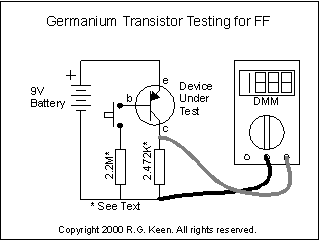 This
is one way to sift the leakage from true gain. You hook up a couple of resistors
and a DMM to the device, and the resistors set up conditions you can control to
see what is what. If you really want to do this, get a 2.2M resistor and a 2.4K
; better, get one each 2.2M and 2.49K metal film 1% resistors. This will set you
back about US$0.30 if you get them from Mouser, and slightly more or less than
that from other sources. If you're going to do much of this, get a transistor
socket to, so you can easily test a large number of devices.
This
is one way to sift the leakage from true gain. You hook up a couple of resistors
and a DMM to the device, and the resistors set up conditions you can control to
see what is what. If you really want to do this, get a 2.2M resistor and a 2.4K
; better, get one each 2.2M and 2.49K metal film 1% resistors. This will set you
back about US$0.30 if you get them from Mouser, and slightly more or less than
that from other sources. If you're going to do much of this, get a transistor
socket to, so you can easily test a large number of devices.
If you are satisfied with an indication of gain but are willing to settle for lower accuracy, you can carbon film at 5%, but recognize that the accuracy will be less. If you can, get several 2.4K resistors and measure them. You may find one that's closer to 2.472 ohms, which would be ideal. I'm being picky about the ohms because if you get exactly 2.2M and 2472 ohms, and use a 9.0V battery, you'll find that the voltage across the resistor will be numerically equal to the indicated gain! That's why the somewhat odd resistor values, and the discussion on the values. It makes the final numbers on your DMM come out about right - multiply the voltage by 100, and that's the gain.
To do the test, stick the transistor in the socket, and read the DC voltage across the 2.4K resistor. The resistor will convert any leakage current from the transistor into a voltage that you can then read on your meter. A 2472 ohm resistor is 2.472 volts per milliamp, so a milliamp of leakage will cause 2.472 volts to display. That is incredibly too much leakage, so any transistor that does that is not going to be useful for a FF. In fact, although it will differ a bit, any transistor that shows more than a few micro amps of leakage is suspect. Because of the resistor scaling, the indicated value on your meter is "false leakage gain" and will have to be subtracted from the total reading that you do next.
To test the total gain, press the switch that connects the 2.2M resistor to the base. This causes a touch more than 4 microamps of base current to flow in the base. The transistor multiplies this by its internal gain, and the sum of the leakage (which doesn't change with base current) and the amplified base current. If the transistor has a gain of 100 and no leakage, the voltage across the 2.4K resistor is then (4uA)*(100)*(2472) = 0.9888V - which is almost exactly 1/ 100 of the actual gain. Pretty neat, huh?
But we know that germanium really does have leakage - that's why were doing this little dance in the first place. So, let's say that the device leaks 100uA to start with. We stick the device into the socket, and read the voltage before we press the switch. It reads (100E-6)*(2472) = 247mV. So the leakage is making the meter believe that there's a "gain" of almost 25 with no current into the base at all.
How much leakage is too much? 100uA is common, 200 happens pretty often. More than 300uA means the device is suspicious, and more than 500uA I would say is bad.
Let's say the device really leaks 93uA, and has a gain of 110 - a prime specimen. What happens when we test? We chuck the thing in the socket, and read (93uA)*(2472) = .229V. Then we press the switch, and read 1.330V. To get the real gain, we subtract 0.229V from 1.330V and get 1.101V. The true gain is just 100 times the reading.
Hey! How come it's 110.1, and not 110? Well, that's from this being an imperfect world, and from this tester being built with some approximations. The exact base current is 4.046...uA, assuming that the transistor's base conducts that much with a forward voltage of 0.1V (reasonable with germanium at these currents) and that the battery is *exactly* 9.0000V, and that the resistors are 2.20000M, and... well, you get the picture. 0.5% accuracy is doggone fine for work with such blunt tools, and much better than you actually need to make a fine sounding FF. Besides - if you're clever, you'll flip the switch and watch the voltage while you put your finger on the transistor. Simple finger heat will make the gain rise rapidly. What's the real gain? All of them are - at the temperature and conditions of the moment.
Don't get too hung up on the exact numbers - they'll change in a second anyway as the device heats or cools. Look for low leakage, and approximately the right gains.
The right *real* gains are from 70 to about 130. Within that range, people report the best sounds. Some people prefer equal gains, others prefer having a lower gain of 70-100 for the first transistor and 90 to 130 for the second.
Silicon versions of the FF???
Yes. The FF was built with several transistor types, including silicon. The first ones seem to have been all AC128's, a PNP germanium device, followed by runs with the Newmarket NKT275, which is very similar. I obtained a batch of NKT275's and they seem to be much more consistent than the AC128, but in other respects very similar. There were several versions with the BC108C and/or BC109/BC109C. These are NPN silicon devices, and the BC108C in particular is a HIGH gain device, typically 500. The reputation of the NPN silicon devices is spotty, although some owners (there's that preferences thing again...) do like them very much.
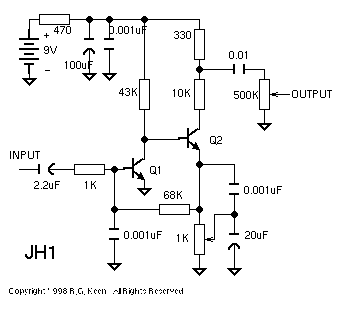
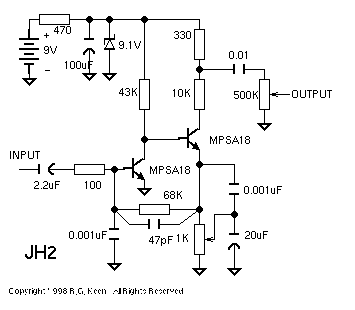
At one point in the past, Dunlop made FF clones. The JH1 and JH2 were both attempts to combine the Fuzz Face circuit with the purchased rights to Jimi's name (bought from the JH estate, as noted on the bottom of the pedal). Both were made with high gain silicon transistors and sounded dreadful (IMHO). The JH2 used the MPSA18, with a typical gain of 900! To my ear, these seem to have a "sticky" or "constricted" quality about them.
Later, Dunlop bought the FF trademarks and began manufacturing the FF as a reissue. Dunlop actually arranged for new manufactured "NKT275" germanium devices to be made for them, and is shipping these in its latest reissues. Reports are that these are OK sounding, much better than the ill-fated JH series.
The JH1 and JH2 are a great value for the DIY'er. You get that neato round case for cheap because they sound horrible. You can then rebuild the real FF circuit onto the circuit board in less than an hour, and have your own great sounding FF.
This all makes good sense - in any device that has so few parts, the qualities of the parts will show through.
I've also done some experimentation with germanium devices
other than the AC128 and NKT275. I found a number of germanium
types, measured their gains, and then listened to them. The results
are pretty consistent - get the right gain and frequency response and
the numbers printed on the cases don't matter. I like the 2N527 from
GE (very consistent!) and the 2N508, also GE. The 508 is a little
hotter, for more of a metal tone. Reports of results on the ECG158
are mixed. Some people are very happy with it, some not. I suspect
that this can be put down to the variablility of the devices. Measure
what you get!!
Mods and Magic
OK, what about things other than the transistors? Roger Mayer is reputed to have tweaked Jimi's gear heavily, so maybe there's some tone to be wrung from the stones there.
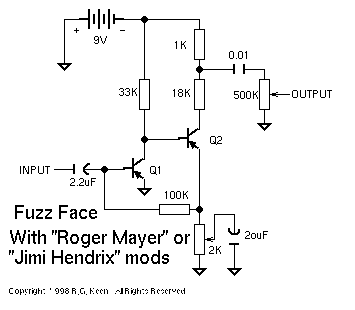
There is a set of changes collectively referred to as the "Hendrix" mods or the "Roger Mayer" mods. These are
Changing the input and output capacitors changes the bass response of the unit. To allow more bass response, you can double each of these capacitors. In the case of the output 0.1uF capacitor, raising it to 0.47uF may be useful. This will prevent the bass signal from being lost by the impedance of the coupling capacitor.
Mike Fuller posted some recommendations on the Fuzz Face to the net. Among those are to add a 1K linear pot in series with the 470 ohm resistor in the collector circuit of the second transistor, still taking the output from the top end of the 8.2 K resistor. The pot is set up so it is acting as a variable resistor, wiper shorted to one end lug. Another is to connect a 50K pot, again as a series resistor, in series with the input of the circuit, before the 2.2uF input capacitor.
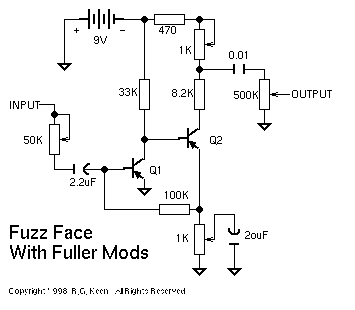
If that last one seems a little odd, think back to what I said about the low input impedance. With a low input impedance, the input loads a guitar significantly; the base can only move a few tens of millivolts before cutting off or saturating the first transistor. If you put a resistor in series with the guitar pickup, it raises the apparent source impedance of the pickup, making it look more like a current source (albeit a tiny one) and less like a voltage source. A signal from a current source lets the input of the effect seek it's own voltage level, and merely supplies a varying current. This can be much more linear than a voltage source drive. As a result, the variable resistor allow you to radically clean up the distortion that the FF produces, producing subtle shades of softer distortion.
In effect, the output mod is a "more" control, and the input mod is a "less" control. As you would expect, the two added controls can interact to produce many shades of distortion.
One person reverse engineered the Fulltone "69" pedal and has posted the 69 pedal schematic to his web page. In this schematic, you can see Fuller's application of his earlier suggestions. The "69" pedal does enjoy a good tone reputation.
If you like softer distortion, you might also like to add some high end taming capacitors. Adding 10 to 100pF from collector to base on the second transistor or 100-680pF across the collector resistor of the first transistor will soften things up a bit.
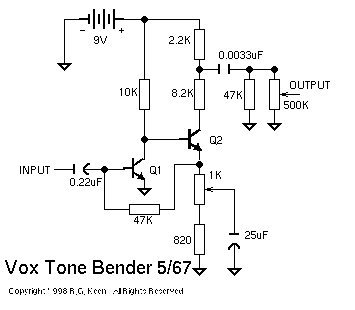
The Fuzz Face also attracted a number of clones even in the Golden Age. The Vox Tone Bender (not to be confused with the Colour Sound Tone Bender) was a copy with only minimal changes to the the component values, and adapted to NPN silicon transistors. There have been several versions of the Vox Tone Bender and the Vox Distortion Booster, all variants on the basic circuit.
There is also a new
Roger Mayer "Classic Fuzz" which employs germanium transistors
and essentially the FF circuit, only a few component value changes. I
suspect that there are many other boutique clones, considering the ease and
simplicity of making the FF circuit. In fact, any of the circuits shown
in this article (with the possible exception of the Fulltone "69" pedal
because of the trimmer pots) can be built on the toner transfer/ready to
solder boards sold at GEO.
In summary...
So - the Fuzz Face is a fortuitous combination of circuits that combine initial soft clipping with asymetrical clipping that changes toward symetrical clipping under drive. It's easy to build, easy to modify, and has a very wide range of tones possible. This thing offers what I consider the most bang for the buck for the enterprising effects hacker. Dig in.... see what magic you can wring out of it.